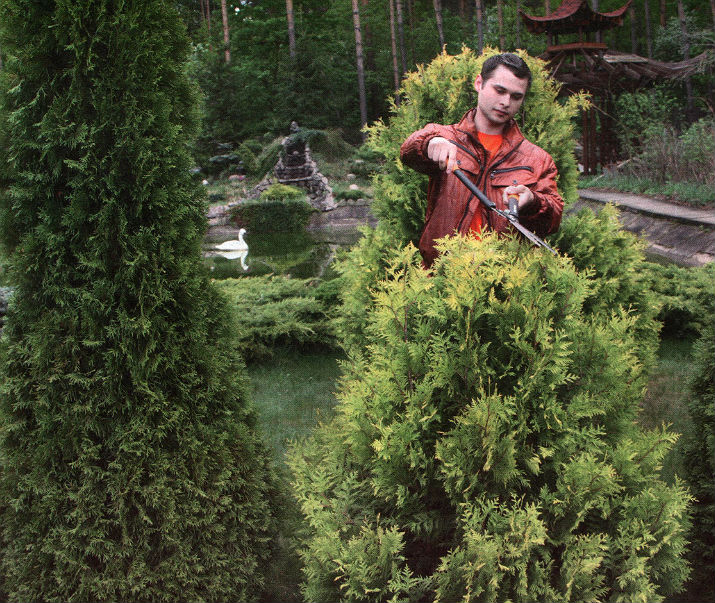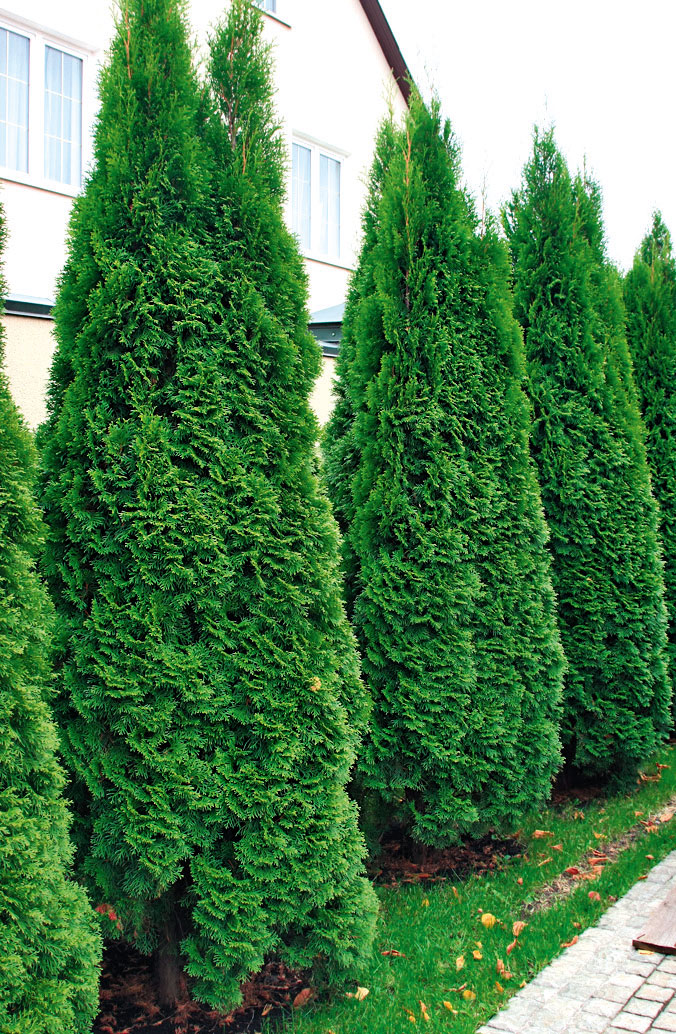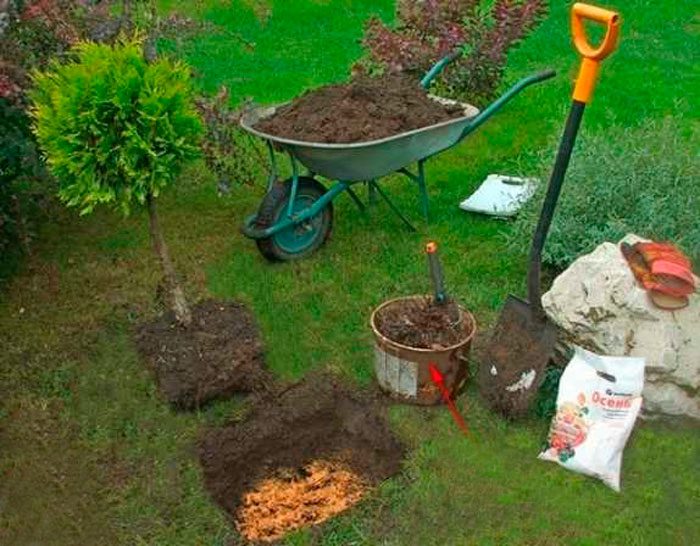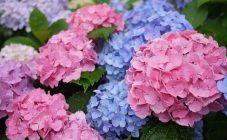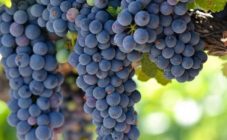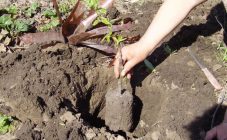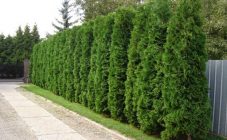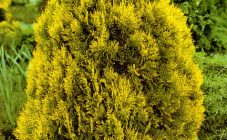Content:
Thuja is a beautiful evergreen plant of the Cypress family. Appreciated for decorativeness, grace, unpretentiousness. Among other conifers, it stands out for its soft, unobtrusive aroma and rich bright green color.
She so naturally blended into the landscapes of our gardens, parks, alleys that it’s hard to believe - this beautiful and delicate plant does not grow in natural conditions on the territory of Russia. The homeland of thuja is North America (hence the other name - "Cypress of the North"), but thanks to its attractiveness and ability to adapt to various climatic conditions, it has spread throughout the world. Under natural conditions, these conifers grow more than 20 m in height. how
domestic, decorative thuja plants rarely exceed 10 m in height.
Features of agricultural technology
Growing thuja does not cause much trouble, provided that some simple principles are followed:
- The soil. The tree grows especially well on fertile, peaty, sandy soils. But, if necessary, you can plant thuja in poor soils. Maybe it will grow and develop at a slower pace, but the beauty of the tree will not suffer from this.
- Moisturizing. Thuja needs watering, it develops well in moist soils. But there are already varieties that are adapted to drought conditions.
- Lighting. The plant loves sunlight, but does not tolerate direct rays, especially in the hot season. The best place for planting is lit in the morning and evening. If there is no alternative, it can be planted in a shaded area.
- Temperature. Due to the variety of varieties, it is possible to grow the tree in almost any temperature conditions. It is very important to choose the right type of thuja, adapted to certain climatic conditions.
Ephedra is grown exclusively in the air: in the open field or in a pot.
Thuja propagates by seeds and cuttings. This is a rather painstaking process, extended over time, but does not require financial costs, the resulting sprouts are already adapted to the characteristics of the habitat. To achieve a faster and more effective result, it is better to purchase a ready-made seedling. The disadvantage of this method is the cost of planting material.
Thuja in Siberia and the Urals planting and care
In order to grow a beautiful tree in difficult Siberian or Ural climatic conditions, you should carefully choose the type of plant and study some of the features of proper care.
One of the most important factors is the choice of a zoned variety. Of the 5 known types of crops for cultivation in these regions, only one species is adapted - western thuja. Since its variety has about 120 varieties, the choice is wide, it is not difficult to choose a tree to taste.
Distinctive characteristics of western thuja:
- High winter hardiness (withstands up to -35 degrees without shelter), drought resistance;
- Slow growth. The age of the tree can reach 150 years, the height is up to - 20 m;
- The crown is pyramidal, conical or oval.
The most popular thuja for the Urals are the Smaragd, Brabant, Woodworth, Dannika varieties.
Thuja in the Urals planting and leaving
A feature of the planting of these conifers in harsh regions is the time they are carried out - preferably in the spring.During the planting period, the seedling is vulnerable, it is sick for some time, it may not have time to take root and gain strength before the onset of frost. There is a risk that the tree will not survive the long winter and will die.
Thuja in Siberia, planting consists of several stages:
- Choosing a place. It is better to choose a well-lit area for planting thuja, but not in the open sun. The composition of the soil does not play a big role. But for swampy, peaty areas unsuitable for growing other crops, thuja is an excellent option.
- Preparation of seedlings. The best option for planting thuja in a harsh climate is a tree with a closed root system. It does not need additional processing and is planted together with the soil. Before planting a seedling with an open system, it should be soaked in water at room temperature with the addition of a growth stimulator or in a weak solution of potassium permanganate.
- Preparation of the landing pit. A hole is dug 50 * 60 cm in size. The distance between plants, depending on the species, can range from half a meter to five meters. At the bottom of the hole, as drainage, rubble or broken brick is laid out. The dug soil is mixed with sand, ash or humus. You can add special mineral fertilizers.
- Planting a seedling. The tree is set in a hole, the roots are straightened, carefully sprinkled with earth, which is periodically compacted. As a result of correct planting, the root collar should be at ground level.
- Leaving after landing. Thuja is watered abundantly. Mulching is carried out with chips, sawdust, peat. This process allows you to maintain the necessary moisture and protects the roots of the plant from frost.
Culture care
Planting thuja is just the beginning of the growing process. To get a beautiful, healthy plant, you need to properly care for it.
Basic principles of proper care:
- Watering. Thuja is a moisture-loving plant that requires regular moisture, especially young trees. During the hot period, watering is carried out at least once a week, preferably in the evening. Thuja also responds well to sprinkling - the crown is well moistened, and dust is washed off. Closer to the middle of autumn, watering stops - the plant must rest before winter.
- Loosening. It is advisable to carry out after each watering or heavy rain. The soil should be loosened carefully and shallowly - the roots of the plant are located close to the surface.
- Pruning. One of the most important processes. It is recommended to trim twice a year: in spring and autumn. First, sanitary pruning is carried out: weak and dry branches are removed. After this, formative pruning is performed. In cold regions, the second pruning should be done in the second half of the summer.
- Top dressing. Thuja develops well without additional fertilizers. If necessary, you can carry out top dressing in the spring in the form of nitrogen fertilizers, in the summer - in the form of potash fertilizers. If complex funds were applied during planting, then re-fertilization is carried out only in the second year.
Tuyu can be used as an ornamental plant, as a tapeworm, and in combination with other conifers. Ferns, barberries, hosts, and echinacea can become interesting neighbors for this ephedra. In addition, thuja can be planted near the house without any problems, it perfectly ionizes the air and is not a fire hazardous plant - the trunk is dense, the branches contain high humidity.
Top dressing and fertilizers
You need to be very careful about feeding the thuja. Excess fertilization leads to a rapid growth of green mass, the crown loses its desired shape. If necessary, the poor condition of the plant, yellowing, slow growth, you can carry out top dressing in the form of complex fertilizers in the spring or alternately with nitrogen, potassium and phosphorus dressings.
Thuja in the suburbs
In the Moscow region, as in the entire central zone of Russia, two types of thuja can be grown: western and folded.
The most popular varieties:
Thuja western:
- Emerald. Easy to grow and absolutely undemanding variety. The color is bright green or yellow. Grows up to 4 m in height and 5 m in spread. It develops as a beautiful pyramid. An important feature is that it holds its shape well even without trimming.
- Brabant. Tall variety. It grows in the form of a column. A sought-after variety due to its fast growth and affordable price. Practically does not change color throughout the year, rather picky about the composition of the soil - it prefers light fertile soils.
- Hoseri. A well-known dwarf variety of emerald color. It grows up to half a meter. Winter hardy, drought tolerant, but sensitive to soil quality. Perfect for small slides or flower beds.
Thuja folded - the highest type of thuja, but prone to freezing:
- Zebrina is an unusual pyramidal variety. It stands out for its original bright green color with white touches. Used as a solitary plant.
- Kornik. Low grade. It is characterized by a beautiful regular column shape. It tolerates a haircut perfectly, but is quite picky about care - it needs feeding, watering, insulation.
Preparing thuja for winter
Despite their endurance, thujas need additional shelter for the winter. Preparation begins in the fall:
- Watering, feeding, trimming stops.
- The branches are pulled together with an elastic cord so that they do not break from the wind or the weight of the snow.
- High hilling and mulching are carried out.
- Dwarf thuja are covered with cardboard or non-woven fabric.
- In the regions of Siberia and the Urals, mini-greenhouses are being built for all thujas.
- With the onset of spring, greenhouses and cardboard can be replaced with lutrasil so that the bright sun does not burn the tree branches.
- The shelter is removed only after the onset of stable heat.
Thuja is a very beautiful ornamental plant that attracts with its graceful form and unobtrusive fresh scent of the forest. The ability to ionize the air makes this ephedra also a very useful plant. Knowing some of the features of growing thuja, you can create a unique evergreen corner that pleases the eye and brings a good mood all year round.
